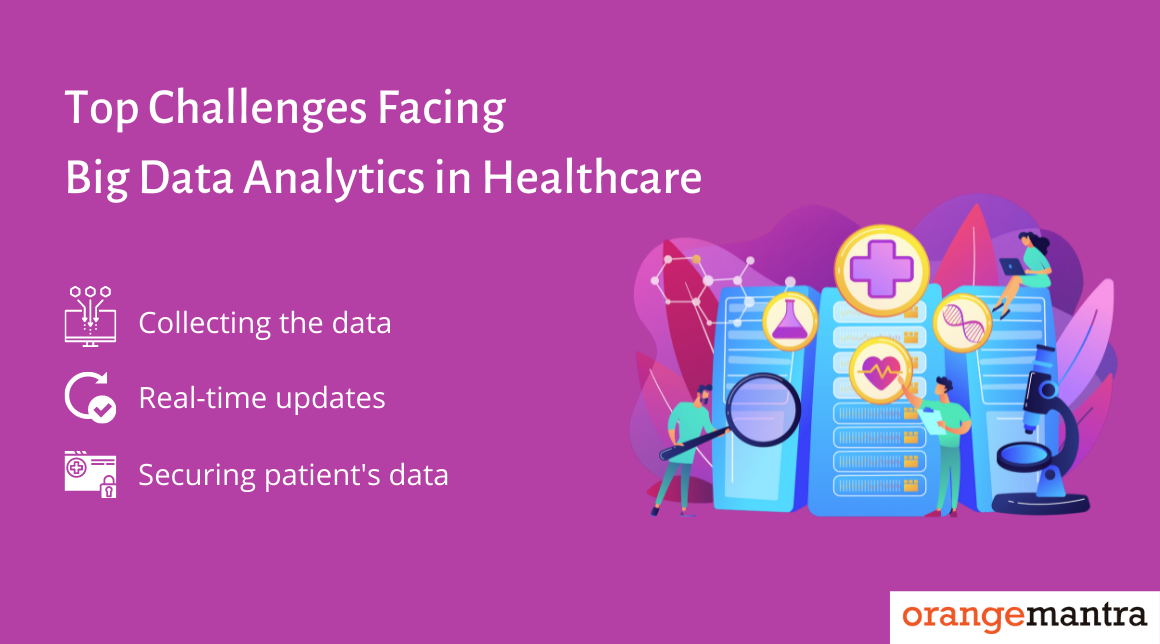When it comes to big data analytics, the healthcare industry faces numerous challenges. These challenges may include security, visualization, and a wide array of data integrity concerns. Over the years, big data analytics in healthcare has emerged as one of the most challenging undertakings for the healthcare industry. For instance, healthcare professionals, who may not be well-versed with managing electronic health records, now need to gather actionable insights as well. Also, they are expected to apply those learnings to complex initiatives that enhance their overall reimbursement rates.
Healthcare organizations that successfully integrate data-driven insights into their clinical and operational workflow get significant results.
Some of the top benefits of turning data assets into data insights include healthier patients, lower care costs, transparent performance, and above all, patient satisfaction. However, it’s not easy to achieve all the goals. In this blog, we shall find out the opportunities and challenges associated with big data analytics in healthcare industry.
Challenges Associated With Big Data Analytics in Healthcare
Collecting the data
Data insights are often retrieved from some source, but for the healthcare industry, they lack data governance habits. As a result, collecting data that is clean, accurate, and complete for use in multiple systems is a daunting task to accomplish.
An incomplete understanding of why big data is crucial for providers is a contributing factor that disrupts data throughout the cycle. Providers can initiate with prioritizing valuable data types for their specific department, enlisting the data governance, and integrity expertise of every healthcare professional. They can also maintain a clinical documentation improvement program to ensure the data is useful for downstream analytics.
Cleaning the data
Many healthcare providers focus on keeping their clinics clean, but they lack keeping their data clean as well. Impure data can immediately derail a big data analytics report, especially when combining disparate data sources in slightly different formats. Data cleaning is referred to as cleansing or scrubbing the data to ensure the datasets are accurate, consistent, relevant, and not influenced by any third party.
Although most of the data cleaning processes are performed manually, some IT vendors offer automated scrubbing tools that implement logic rules to compare, contrast, and correct large datasets. These tools are highly sophisticated and precise as machine learning techniques are getting advanced. It saves time, money, and ensures high levels of accuracy and integrity in the healthcare sector.
Data storage
Frontline doctors and health practitioners merely give a thought to where their data is being stored. But for the IT department, this information is crucial as it may raise security and performance risks. With growing healthcare data, many providers no longer keep track of their costs. As a result, it creates a substantial impact on the premise of data centers.
Although many providers feel it safe to store their data on-premises data centers. However, it can be expensive to scale, difficult to maintain, and prone to producing data silos across various departments. On the other hand, cloud storage offers nimble disaster recovery, lower up-front costs, and easy expansion.
Many healthcare providers end up using a hybrid approach for their data storage programs. However, while developing a hybrid infrastructure, providers must ensure that disparate systems can communicate and share data with other segments of the organization if required.
Securing patients’ data
Data security is the most crucial priority for healthcare organizations, especially with the risks of rapid-fire series of high-profile cyber-attacks and ransomware episodes. The HIPAA security rule includes a list of technical safeguards for healthcare organizations to protect health information, including transmission security, authentication protocols, and controls over access, integrity, and auditing.
These safeguards translate into common security procedures like using updated anti-virus software, setting up firewalls, encrypting sensitive data, and implementing multi-factor authentication. However, even top-level security cannot ensure the fallibility of human staff members who tend to think about their convenience over hectic software updates and complicated constraints on data and software.
Healthcare organizations must always remind their staff members of the highly volatile nature of data security protocols and constantly review who has access to high-value data assets to avoid any third-party causing damage or threats.
Querying the Data
Robust metadata and effective stewardship protocols make it easy for healthcare organizations to query their data and get the answers on time. The ability to ask questions is the foundation of report and analytics, but the providers have to face numerous challenges before engaging in meaningful analysis of their big data assets.
Many organizations use Structured Query Language (SQL) to fetch large datasets and relational databases, but it is also an effective solution for users who trust the accuracy, completeness, and standardization of the data available.
Real-time updates
Healthcare data are not always the same. Most of the elements require frequent updates to stay relevant. Understanding the sensitivity of big data, or how often and to what extent it should change, is a challenge for healthcare providers who don’t consistently monitor their data assets.
Many providers keep track of which datasets need manual updating and which can get automated. Also, they ensure to complete a process without the downtime and update the dataset without damaging its quality and integrity.
Providers ensure that they don’t create duplicate records while attempting to update an individual element. Any duplicity will make it challenging for healthcare providers to access crucial information for patients’ health-related decision-making process.
Summing it up
The benefits of big data for healthcare is enormous. Smart machines and algorithms can help process large data that a human brain can not possibly comprehend; as a result, big data helps with early diagnostics, treatments, and accurate forecasts.
Most importantly, the large amounts of data fed into the algorithm not only can it help make better decisions, but also enhance speed and performance.
At Orange Mantra, we ensure our team caters to the needs of our valued clients when it comes to offering the best big data analytics and services. Get in touch with our well-renowned team to get further insights on big data for the healthcare industry.
FAQs
1. What do you mean by big data for the healthcare industry?
Big data in healthcare is defined concerning the three “Vs”:
- Volume:Maintaining a large amount of data
- Velocity:Ensure the data arrives at high speed
- Variety:Monitor the different types of data
In simple words, big data in healthcare refers to largely routinely or automatically collected datasets that are collected electronically and stored for future references. It is reusable and connects the existing database to improve patients’ health and health system performance.
2. Who can use Big Data for healthcare?
Big Data can be used by healthcare providers, academia, policymakers, and the industry. A few examples of the use of Big Data in healthcare are:
- To achieve better health outcomes
- To improve the effectiveness of treatments and increase patient safety
- To monitor healthcare services
- To detect population-level effects
- To get more efficient recruitment and patients’ selection for clinical trials
3. What are the benefits of using Big Data for patients?
Big Data is attributed to having “transformative potential” in healthcare systems, with benefits across the entire pathway of care delivery for the stakeholders.
Linkage of previously separated data sets and their analysis using Big Data analytics offer new ways to accelerate research and identify the right treatment for individual patients (personalized medicine).
Access to large data sets gives a more comprehensive picture of patient’s health condition, allows patient-related outcomes to be measured perfectly, and supports decision-makers in taking the right decision for the entire healthcare system.























